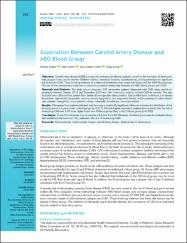| dc.contributor.author | Kutlay, Özden | |
| dc.contributor.author | Yalim, Zafer | |
| dc.contributor.author | Keskin Aktan, Arzu | |
| dc.contributor.author | Koca, Tülay | |
| dc.date.accessioned | 2023-11-06T12:32:36Z | |
| dc.date.available | 2023-11-06T12:32:36Z | |
| dc.date.issued | 2022 | en_US |
| dc.identifier.citation | Kutlay, Ö., Yalım, Z., Aktan, A. K., & Koca, T. (2022). Association Between Carotid Artery Disease and ABO Blood Group. Erciyes Medical Journal/Erciyes Tip Dergisi, 44(3). | en_US |
| dc.identifier.issn | 2149-2549 | |
| dc.identifier.uri | https://dx.doi.org/10.14744/etd.2021.70670 | |
| dc.identifier.uri | https://hdl.handle.net/20.500.12933/1697 | |
| dc.description.abstract | Objective: Carotid artery disease (CAD) is a type of cardiovascular disease typically caused by the formation of atherosclerotic plaques in the carotid arteries. Diabetes mellitus, hereditary features, hyperlipidemia, and hypertension are significant risk factors for CAD. There is strong evidence of a relationship between these major risk factors and the ABO blood groups. The aim of this retrospective study was to examine a potential relationship between the ABO blood groups and CAD. Materials and Methods: The study group comprised 230 consecutive patients diagnosed with CAD using carotid angiography between January 2012 and November 2019 and 136 consecutive subjects without CAD as controls. The data analyzed were collected from patient files: details of demographic characteristics, lipid profiles (total cholesterol, low-density lipoprotein, high-density lipoprotein, very-low-density lipoprotein, and triglyceride levels), and hematological indices (leukocyte, platelet, hemoglobin, mean platelet volume, neutrophil, lymphocyte, monocyte values). Results: Chi-squared test analysis indicated that there was a statistically significant difference between the distribution of the blood groups in the patient and control groups (p=0.017). Multiple logistic regression analysis demonstrated that the risk of developing CAD was 1.92 times higher in the non-O blood groups than in the O blood group (p=0.032). Conclusion: A non-O blood group may be another risk factor for CAD. However, the blood group must be evaluated alongside established risk factors to fully understand the risk of developing CAD. | en_US |
| dc.language.iso | eng | en_US |
| dc.publisher | Ali Cangül | en_US |
| dc.relation.isversionof | 10.14744/etd.2021.70670 | en_US |
| dc.rights | info:eu-repo/semantics/openAccess | en_US |
| dc.title | Association between carotid artery disease and ABO blood group | en_US |
| dc.type | article | en_US |
| dc.authorid | 0000-0001-5509-6650 | en_US |
| dc.department | AFSÜ | en_US |
| dc.contributor.institutionauthor | Kutlay, Özden | |
| dc.contributor.institutionauthor | Yalim, Zafer | |
| dc.contributor.institutionauthor | Keskin Aktan, Arzu | |
| dc.contributor.institutionauthor | Koca, Tülay | |
| dc.identifier.volume | 44 | en_US |
| dc.identifier.issue | 3 | en_US |
| dc.identifier.startpage | 293 | en_US |
| dc.identifier.endpage | 298 | en_US |
| dc.relation.journal | Erciyes Medical Journal | en_US |
| dc.relation.publicationcategory | Makale - Uluslararası Hakemli Dergi - Kurum Öğretim Elemanı | en_US |
















